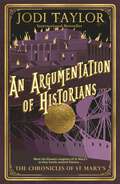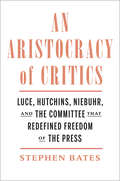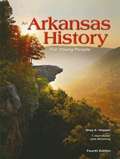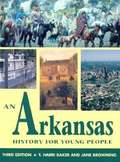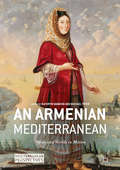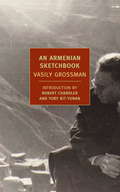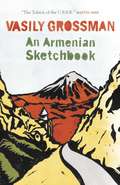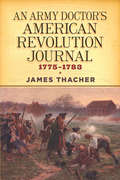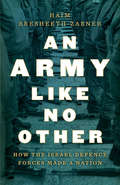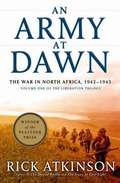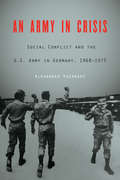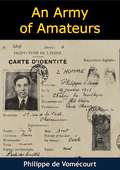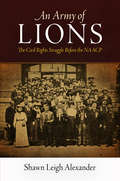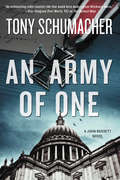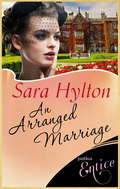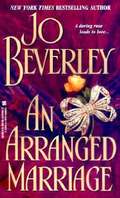- Table View
- List View
An Argumentation of Historians (Chronicles of St. Mary's #9)
by Jodi TaylorThe ninth book in the bestselling Chronicles of St Mary's series which follows a group of tea-soaked disaster magnets as they hurtle their way around History. If you love Jasper Fforde or Ben Aaronovitch, you won't be able to resist Jodi Taylor.They say you shouldn't push your luck. Max gives her own luck a massive shove every day - and it's only a matter of time until luck pushes back... January 1536 - the day of Henry VIII's infamous jousting accident. Historians from St Mary's are there in force, recording and documenting. And, arguing - obviously.A chance meeting between Max and the Time Police leads to a plan of action. And, it's one that will have very serious consequences - especially for Max. Her private life is already more than a little rocky. But with Leon recovering and Matthew safe in the future there will never be a better opportunity to bring down Clive Ronan, once and for all.From Tudor England to the burning city of Persepolis - and from a medieval siege to a very nasty case of 19th century incarceration - Max is determined that this time, he will not escape. Readers love Jodi Taylor: 'Once in a while, I discover an author who changes everything... Jodi Taylor and her protagonista Madeleine "Max" Maxwell have seduced me' 'A great mix of British proper-ness and humour with a large dollop of historical fun' 'Addictive. I wish St Mary's was real and I was a part of it' 'Jodi Taylor has an imagination that gets me completely hooked' 'A tour de force'
An Argumentation of Historians: The Chronicles Of St. Mary's Book Nine (Chronicles of St. Mary's #9)
by Jodi TaylorThe ninth book in the bestselling Chronicles of St Mary's series which follows a group of tea-soaked disaster magnets as they hurtle their way around History. If you love Jasper Fforde or Ben Aaronovitch, you won't be able to resist Jodi Taylor.They say you shouldn't push your luck. Max gives her own luck a massive shove every day - and it's only a matter of time until luck pushes back... January 1536 - the day of Henry VIII's infamous jousting accident. Historians from St Mary's are there in force, recording and documenting. And, arguing - obviously.A chance meeting between Max and the Time Police leads to a plan of action. And, it's one that will have very serious consequences - especially for Max. Her private life is already more than a little rocky. But with Leon recovering and Matthew safe in the future there will never be a better opportunity to bring down Clive Ronan, once and for all.From Tudor England to the burning city of Persepolis - and from a medieval siege to a very nasty case of 19th century incarceration - Max is determined that this time, he will not escape. Readers love Jodi Taylor: 'Once in a while, I discover an author who changes everything... Jodi Taylor and her protagonista Madeleine "Max" Maxwell have seduced me' 'A great mix of British proper-ness and humour with a large dollop of historical fun' 'Addictive. I wish St Mary's was real and I was a part of it' 'Jodi Taylor has an imagination that gets me completely hooked' 'A tour de force'
An Aristocracy of Critics: Luce, Hutchins, Niebuhr, and the Committee That Redefined Freedom of the Press
by Stephen BatesThe story behind the 1940s Commission on Freedom of the Press—groundbreaking then, timelier than ever now"A well-constructed, timely study, clearly relevant to current debates."—Kirkus, starred review In 1943, Time Inc. editor-in-chief Henry R. Luce sponsored the greatest collaboration of intellectuals in the twentieth century. He and University of Chicago president Robert Maynard Hutchins summoned the theologian Reinhold Niebuhr, the Pulitzer-winning poet Archibald MacLeish, and ten other preeminent thinkers to join the Commission on Freedom of the Press. They spent three years wrestling with subjects that are as pertinent as ever: partisan media and distorted news, activists who silence rather than rebut their opponents, conspiracy theories spread by shadowy groups, and the survivability of American democracy in a post-truth age. The report that emerged, A Free and Responsible Press, is a classic, but many of the commission&’s sharpest insights never made it into print. Journalist and First Amendment scholar Stephen Bates reveals how these towering intellects debated some of the most vital questions of their time—and reached conclusions urgently relevant today.
An Aristotelian Feminism (Historical-Analytical Studies on Nature, Mind and Action #1)
by Sarah Borden SharkeyThis book articulates the theoretical outlines of a feminism developed from Aristotle's metaphysics, making a new contribution to feminist theory. Readers will discover why Aristotle was not a feminist and how he might have become one, through an investigation of Aristotle and Aristotelian tradition. The author shows how Aristotle's metaphysics can be used to articulate a particularly subtle and theoretically powerful understanding of gender that may offer a highly useful tool for distinctively feminist arguments. This work builds on Martha Nussbaum's 'capabilities approach' in a more explicitly and thoroughly hylomorphist way. The author shows how Aristotle's hylomorphic model, developed to run between the extremes of Platonic dualism and Democritean atomism, can similarly be used today to articulate a view of gender that takes bodily differences seriously without reducing gender to biological determinations. Although written for theorists, this scholarly yet accessible book can be used to address more practical issues and the final chapter explores women in universities as one example. This book will appeal to both feminists with limited familiarity with Aristotle's philosophy, and scholars of Aristotle with limited familiarity with feminism.
An Aristotelian Realist Philosophy of Mathematics
by James FranklinMathematics is as much a science of the real world as biology is. It is the science of the world's quantitative aspects (such as ratio) and structural or patterned aspects (such as symmetry). The book develops a complete philosophy of mathematics that contrasts with the usual Platonist and nominalist options.
An Arkansas History for Young People
by T. Harri Baker Jane Browning Shay E. HopperAn Arkansas History for Young People is an official textbook for middle-level and/or junior-high-school Arkansas-history classes. This fourth edition incorporates new research done after extensive consultations with middle-level and junior-high teachers from across the state, curriculum coordinators, literacy coaches, university professors, and students themselves.
An Arkansas History for Young People (3rd Edition)
by T. Harri Baker Jane BrowningThis third edition incorporates the fruits of new research and of extensive consultations with teachers, curriculum supervisors, and students themselves. It includes many new features while preserving popular and useful aspects of previous editions. The updated text incorporates new material on the Clinton presidency, the Huckabee governorship, term limits, the 2000 census, demographic changes, recent scholarship on Arkansas history, updated terminology, and corrections of factual errors.
An Armenian Mediterranean: Words And Worlds In Motion (Mediterranean Perspectives)
by Kathryn Babayan Michael PiferOffers fresh perspectives on the study of Armenian history, literature, and visual culture.<P> Appeals to scholars of comparative literature, global history, Mediterranean studies, Armenian studies, and medieval history.<P> Draws from and contributes to a wide array of comparative and theoretical frameworks, including world history, world literature, and Mediterranean studies.<P> This book rethinks the Armenian people as significant actors in the context of Mediterranean and global history. Spanning a millennium of cross-cultural interaction and exchange across the Mediterranean world, essays move between connected histories, frontier studies, comparative literature, and discussions of trauma, memory, diaspora, and visual culture. Contributors dismantle narrow, national ways of understanding Armenian literature; propose new frameworks for mapping the post-Ottoman Mediterranean world; and navigate the challenges of writing national history in a globalized age. A century after the Armenian genocide, this book reimagines the borders of the “Armenian,” pointing to a fresh vision for the field of Armenian studies that is omnivorously comparative, deeply interconnected, and rich with possibility.
An Armenian Sketchbook
by Robert Chandler Elizabeth Chandler Vasily Grossman Yury Bit-YunanAn NYRB Classics OriginalFew writers had to confront as many of the last century's mass tragedies as Vasily Grossman, who wrote with terrifying clarity about the Shoah, the Battle of Stalingrad, and the Terror Famine in the Ukraine. An Armenian Sketchbook, however, shows us a very different Grossman, notable for his tenderness, warmth, and sense of fun. After the Soviet government confiscated--or, as Grossman always put it, "arrested"--Life and Fate, he took on the task of revising a literal Russian translation of a long Armenian novel. The novel was of little interest to him, but he needed money and was evidently glad of an excuse to travel to Armenia. An Armenian Sketchbook is his account of the two months he spent there. This is by far the most personal and intimate of Grossman's works, endowed with an air of absolute spontaneity, as though he is simply chatting to the reader about his impressions of Armenia--its mountains, its ancient churches, its people--while also examining his own thoughts and moods. A wonderfully human account of travel to a faraway place, An Armenian Sketchbook also has the vivid appeal of a self-portrait. the censors' demand. As a result, An Armenian Sketchbook was published only posthumously. A bowdlerized Russian text was published in 1967 and a complete text in 1988. This is the first English translation.
An Armenian Sketchbook
by Vasily GrossmanFew writers had to confront so many of the last century's mass tragedies as Vasily Grossman. He is likely to be remembered, above all, for the terrifying clarity with which he writes about the Shoah, the Battle of Stalingrad and the Terror Famine in the Ukraine. An Armenian Sketchbook, however, shows us a very different Grossman; it is notable for its warmth, its sense of fun and for the benign humility that is always to be found in his writing. After the 'arrest' - as Grossman always put it - of Life and Fate, Grossman took on the task of editing a literal Russian translation of a lengthy Armenian novel. The novel was of little interest to him, but he was glad of an excuse to travel to Armenia. This is his account of the two months he spent there. It is by far the most personal and intimate of Grossman's works, with an air of absolute spontaneity, as though Grossman is simply chatting to the reader about his impressions of Armenia - its mountains, its ancient churches and its people.
An Army At Dawn: The War in North Africa, 1942-1943 (Liberation Trilogy #1)
by Rick AtkinsonThe liberation of Europe and the destruction of the Third Reich is a story of courage and enduring triumph, of calamity and miscalculation. In this first volume of the Liberation Trilogy, Rick Atkinson shows why no modern reader can understand the ultimate victory of the Allied powers without a grasp of the great drama that unfolded in North Africa in 1942 and 1943.Beginning with the daring amphibious invasion in November 1942, An Army at Dawn follows the British and American armies as they fight the French in Morocco and Algeria, and then take on the Germans and Italians in Tunisia. Battle by battle, an inexperienced and sometimes poorly led army gradually becomes a superb fighting force. Central to the tale are the extraordinary but fallible commanders who come to dominate the battlefield: Eisenhower, Patton, Bradley, Montgomery and Rommel.
An Army Doctor on the Western Frontier: Journals and Letters of John Vance Lauderdale, 1864-1890
by Robert M. UtleyAssigned to the District of Utah during the Civil War, physician John Vance Lauderdale spent the next twenty-five years on army posts in the American West, serving in California, Arizona, New Mexico, South Dakota, and Texas. Throughout his career he kept a detailed journal and sent long letters home to his sister in upstate New York. This selection of Lauderdale&’s writings, edited and annotated by a premier historian of the American West, offers an insightful account of army life that will teach readers much about the settlement and growth of the West in a time of rapid change.Lauderdale&’s observations are keen and critical. He writes about fellow officers, his army superiors, the civilians and American Indians he encountered, life on officers&’ row, and the day-to-day functioning of the army medical service. Particularly valuable are his insights into military interactions with local communities of Mormons, American Indians, and Hispanos.
An Army Doctor's American Revolution Journal, 1775–1783 (Dover Military History, Weapons, Armor)
by James ThacherAt the age of 21, James Thacher (1754–1844) joined the newly formed American army as a surgeon's mate, eventually advancing to the role of surgeon for the Massachusetts 16th Regiment. In 1823, he published his Journal, reporting both wartime events he witnessed and those he heard about during his service. One of the most valuable and entertaining accounts to have survived the Revolution, Thacher's diary vividly conveys the tumultuous spirit of the era.Thacher's eyewitness reports include the siege of Boston, the hanging of British major John André, and the momentous defeats of the British Army at Saratoga and Yorktown. His direct and vivid observations range from parties where he and his fellow officers were handsomely entertained by supporters of the new nation's army to hardscrabble days when there was little to eat and nowhere to keep warm. With its cogent overview of the war's major campaigns and battles, its insights into the character of Revolutionary leaders, and its firsthand views of the daily life of a Continental Army officer, the Journal provides a heightened sense of the drama and excitement of the Revolution.
An Army Like No Other: How the Israel Defense Forces Made a Nation
by Haim Bresheeth-ZabnerA history of the IDF that argues that Israel is a nation formed by its army.The Israeli army, officially named the Israel Defence Forces (IDF), was established in 1948 by David Ben-Gurion, Israel's first prime minister, who believed that 'the whole nation is the army'. In his mind, the IDF was to be an army like no other. It was the instrument that might transform a diverse population into a new people. Since the foundation of Israel, therefore, the IDF has been the largest, richest and most influential institution in Israel's Jewish society and is the nursery of its social, economic and political ruling class. In this fascinating history, Bresheeth charts the evolution of the IDF from the Nakba to the continued assaults upon Gaza, and shows that the state of Israel has been formed out of its wars. He also gives an account of his own experiences as a young conscript during the 1967 war. He argues that the army is embedded in all aspects of daily life and identity. And that we should not merely see it as a fighting force enjoying an international reputation, but as the central ideological, political and financial institution of Israeli society. As a consequence, we have to reconsider our assumptions on what any kind of peace might look like.
An Army at Dawn: The War in North Africa, 1942-1943 (Liberation Trilogy #1)
by Rick AtkinsonThe liberation of Europe and the destruction of the Third Reich is a story of courage and enduring triumph, of calamity and miscalculation. In this first volume of the Liberation Trilogy, Rick Atkinson shows why no modern reader can understand the ultimate victory of the Allied powers without a grasp of the great drama that unfolded in North Africa in 1942 and 1943. That first year of the Allied war was a pivotal point in American history, the moment when the United States began to act like a great power.<P><P> Beginning with the daring amphibious invasion in November 1942, An Army at Dawn follows the American and British armies as they fight the French in Morocco and Algeria, and then take on the Germans and Italians in Tunisia. Battle by battle, an inexperienced and sometimes poorly led army gradually becomes a superb fighting force. Central to the tale are the extraordinary but fallible commanders who come to dominate the battlefield: Eisenhower, Patton, Bradley, Montgomery, and Rommel.<P> Brilliantly researched, rich with new material and vivid insights, Atkinson's narrative provides the definitive history of the war in North Africa.<P> Pulitzer Prize Winner
An Army in Crisis: Social Conflict and the U.S. Army in Germany, 1968–1975
by Alexander VazanskyFollowing the decision to maintain 250,000 U.S. troops in Germany after the Allied victory in 1945, the U.S. Army had, for the most part, been a model of what a peacetime occupying army stationed in an ally’s country should be. The army had initially benefited from the positive results of U.S. foreign policy toward West Germany and the deference of the Federal Republic toward it, establishing cordial and even friendly relations with German society. By 1968, however, the disciplined military of the Allies had been replaced with rundown barracks and shabby-looking GIs, and U.S. bases in Germany had become a symbol of the army’s greatest crisis, a crisis that threatened the army’s very existence. In An Army in Crisis Alexander Vazansky analyzes the social crisis that developed among the U.S. Army forces stationed in Germany between 1968 and 1975. This crisis was the result of shifting deployment patterns across the world during the Vietnam War; changing social and political realities of life in postwar Germany and Europe; and racial tensions, drug use, dissent, and insubordination within the U.S. Army itself, influenced by the civil rights movement, the Vietnam War, and the youth movement in the States. With particular attention to 1968, An Army in Crisis examines the changing relationships between American and German soldiers, from German deference to familiarity and fraternization, and the effects that a prolonged military presence in Germany had on American military personnel, their dependents, and the lives of Germans. Vazansky presents an innovative study of opposition and resistance within the ranks, affected by the Vietnam War and the limitations of personal freedom among the military during this era.
An Army of Amateurs
by Philippe De VomécourtThis book is the fascinating firsthand account of SOE agent Philippe Vomécourt's wartime experiences and records the heroic efforts in the French resistance in Nazi-dominated France."Many books dealing with the work of the French Resistance have been published on this side of the Channel. Most of them have been the personal stories of gallant men and women, illuminating that corner of the picture that they saw. Here in Monsieur de Vomécourt's book is a wider frame of reference which enables us to see how the spirit and forces of Resistance grew in France first into a gadfly nuisance and ultimately into a serious threat to German security. It shows, too, what it meant to be a member of the Resistance, and what it cost in blood and tears.Monsieur de Vomécourt is in a good position to tell this story. He was in at the beginning in June 1940 with his brothers. Indeed, they can fairly claim to have been the first organizers and leaders, and Monsieur de Vomécourt tells a truly remarkable story.
An Army of Influence: Eighty Years of Regional Engagement
by Peter Dennis Craig StockingsThe importance of regional cooperation is becoming more apparent as the world moves into the third decade of the 21st century. An Army of Influence is a thought-provoking analysis of the Australian Army's capacity to change, with a particular focus on the Asia-Pacific region. Written by highly regarded historians, strategists and practitioners, this book examines the Australian Army's influence abroad and the lessons it has learnt from its engagement across the Asia-Pacific region. It also explores the challenges facing the Australian Army in the future and provides principles to guide operational, administrative and modernisation planning. Containing full-colour maps and images, An Army of Influence will be of interest to both the wider defence community and general readers. It underscores the importance of maintaining an ongoing presence in the region and engages with history to address the issues facing the Army both now and into the future.
An Army of Lions
by Shawn Leigh AlexanderIn January 1890, journalist T. Thomas Fortune stood before a delegation of African American activists in Chicago and declared, "We know our rights and have the courage to defend them," as together they formed the Afro-American League, the nation's first national civil rights organization. Over the next two decades, Fortune and his fellow activists organized, agitated, and, in the process, created the foundation for the modern civil rights movement.An Army of Lions: The Civil Rights Struggle Before the NAACP traces the history of this first generation of activists and the organizations they formed to give the most comprehensive account of black America's struggle for civil rights from the end of Reconstruction to the formation of the National Association for the Advancement of Colored People in 1909. Here a host of leaders neglected by posterity--Bishop Alexander Walters, Mary Church Terrell, Jesse Lawson, Lewis G. Jordan, Kelly Miller, George H. White, Frederick McGhee, Archibald Grimké--worked alongside the more familiar figures of Ida B. Wells-Barnett, W. E. B. Du Bois, and Booker T. Washington, who are viewed through a fresh lens.As Jim Crow curtailed modes of political protest and legal redress, members of the Afro-American League and the organizations that formed in its wake--including the Afro-American Council, the Niagara Movement, the Constitution League, and the Committee of Twelve--used propaganda, moral suasion, boycotts, lobbying, electoral office, and the courts, as well as the call for self-defense, to end disfranchisement, segregation, and racial violence. In the process, the League and the organizations it spawned provided the ideological and strategic blueprint of the NAACP and the struggle for civil rights in the twentieth century, demonstrating that there was significant and effective agitation during "the age of accommodation."
An Army of One: A John Rossett Novel (The John Rossett Novels)
by Tony SchumacherIn this enthralling historical thriller set in post—World War II London, detective John Henry Rossett must stop a murderous ex—SS officer as the German occupation of England begins to falter.Working with the SS in German-occupied Britain was never easy for John Rossett. Though he’s returned to his former job, the police inspector has been tainted by his Nazi associations. His suspicious colleagues see him as a collaborator, and he’s unwelcome at his old haunts. But the Germans aren’t done with Rossett. When decorated SS Captain Karl Bauer kills the US consul in Liverpool, then goes on the run, Generalmajor Neumann orders Rossett to find the missing killer—a swift, cunning, and ruthless man known as "the Bear."While the Nazis still maintain control over London, Liverpool is run by criminal networks and the British resistance. A wasteland of burned-out buildings and mountains of rubble, the northern port city is the perfect place for a clever warrior like Bauer to hide. Neumann and Rossett’s search also turns up damning new information: Bauer’s superior, Major Theo Dannecker, has been colluding with the US consul and the British resistance to smuggle large amounts of gold out of the country. As for the Bear, the fervent SS officer has repudiated his allegiance to the crumbling Reich and is now focused on destroying Rossett, the famed "British Lion," one innocent victim at a time.To prevent more deaths and protect Britain, Rossett must trap the Bear and uncover a diabolical conspiracy that has brought Nazi officers and the British resistance together. Vivid and energetic, full of Schumacher’s trademark action and rich, conflicted characters, An Army of One reveals how the strength of one man can turn the tide in an uncertain world.
An Army of Phantoms: American Movies and the Making of the Cold War
by J. HobermanThe film critic&’s sweeping analysis of American cinema in the Cold War era is both &“utterly compulsive reading [and] majestic&” in its &“breadth and rigor&” (Film Comment). An Army of Phantoms is a major work of film history and cultural criticism by leading film critic J. Hoberman. Tracing the dynamic interplay between politics and popular culture, Hoberman offers &“the most detailed year-by-year look at Hollywood during the first decade of the Cold War ever published, one that takes film analysis beyond the screen and sets it in its larger political context&” (Los Angeles Review of Books). By &“tell[ing] the story not just of what&’s on the screen but of what played out behind it,&” Hoberman demonstrates how the nation&’s deep-seated fears and wishes were projected onto the big screen. In this far-reaching work of historical synthesis, Cecil B. DeMille rubs shoulders with Douglas MacArthur, atomic tests are shown on live TV, God talks on the radio, and Joe McCarthy is bracketed with Marilyn Monroe (The American Scholar). From cavalry Westerns to apocalyptic sci-fi flicks, and biblical spectaculars; from movies to media events, congressional hearings and political campaigns, An Army of Phantoms &“remind[s] you what criticism is supposed to be: revelatory, reflective and as rapturous as the artwork itself&” (Time Out New York). &“An epic . . . alternately fevered and measured account of what might be called the primal scene of American cinema.&” —Cineaste &“There&’s something majestic about the reach of Hoberman&’s ambitions, the breadth and rigor of his research, and especially the curatorial vision brought to historical data.&” —Film Comment
An Army of Smiles
by Grace ThompsonThree girls go to war and find true friendship in this Second World War saga from the popular author of the Holidays at Home and Pendragon Island series. Ethel runs away from a violent father, a man so fierce he beat her fiancé senseless. Gorgeous Kate leaves her doting parents and their grocery store. Shy and sheltered Rosie, who has grown up with her grandmother, decides to escape her sleepy hometown. All three join the NAAFI, determined to do their bit against Hitler. Through the travails of war, they become each other&’s new family. Through desperate love affairs, charming pilots, unplanned pregnancies and postings around war-torn Europe, they resolve to stick together. But will the war tear them apart? And when the fighting draws to an end they realize the world—and their lives—can never be the same again . . .
An Arranged Marriage
by Sara HyltonLisa Foreshaw grows up torn between two worlds, and regarded as poor relations by her family, Lisa is never allowed to forget her place. Despite this she falls in love with her handsome and charming cousin Dominic, the Viscount Lexican and heir to Hazelmere. But Dominic has a secret his family is willing to protect at all costs. Blissfully ignorant of Dominic's true feelings, Lisa allows herself to be tempted into marriage by her mother's unscrupulous family who would rather sacrifice both Lisa and Dominic's happiness than see the family's reputation ruined. But Lisa's honeymoon provides a rude awakening, and when she discovers what her own family have done to her, she vows to take revenge . . . Discover Piatkus Entice: temptation at your fingertips - www.piatkusentice.co.uk
An Arranged Marriage
by Sara HyltonLisa Foreshaw grows up torn between two worlds, and regarded as poor relations by her family, Lisa is never allowed to forget her place. Despite this she falls in love with her handsome and charming cousin Dominic, the Viscount Lexican and heir to Hazelmere. But Dominic has a secret his family is willing to protect at all costs. Blissfully ignorant of Dominic's true feelings, Lisa allows herself to be tempted into marriage by her mother's unscrupulous family who would rather sacrifice both Lisa and Dominic's happiness than see the family's reputation ruined. But Lisa's honeymoon provides a rude awakening, and when she discovers what her own family have done to her, she vows to take revenge . . . Discover Piatkus Entice: temptation at your fingertips - www.piatkusentice.co.uk
An Arranged Marriage (Company of Rogues #1)
by Jo BeverleyFirst book of the Company of Rogues collection. A RELUCTANT BRIDE Eleanor Chivenham didn't put much past her vile brother, but even she had not anticipated his greedy scheme to dupe a rich earl into mistaking her for a lightskirt. With her reputation in shreds and her future ruined, a defeated Eleanor was forced to agree to a hasty wedding. But marriage to the mysterious Nicholas Delaney, with his casual elegance and knowing smile, was more than she'd bargained for. He doubtless thought the worst of her, but when society gossip soon told her all about his beautiful French mistress, Eleanor tried to act with the cool dignity required in a marriage of convenience. But how long could she hold out against his undeniable charm-or the secret desires of her heart? A PERSUASIVE GROOM For the sake of family honor, Nicholas Delaney agreed to wed a wronged lady. In truth, such chivalry ran counter to his carefully wrought image of a carousing, dissolute rogue-the guise so vital to his secret political mission. He hoped to keep his new wife in the background until a spy was trapped, but Eleanor's beauty and fighting wit were impossible to ignore. In fact, she presented quite a challenge to his prowess with women-and a test of his formidable will!
